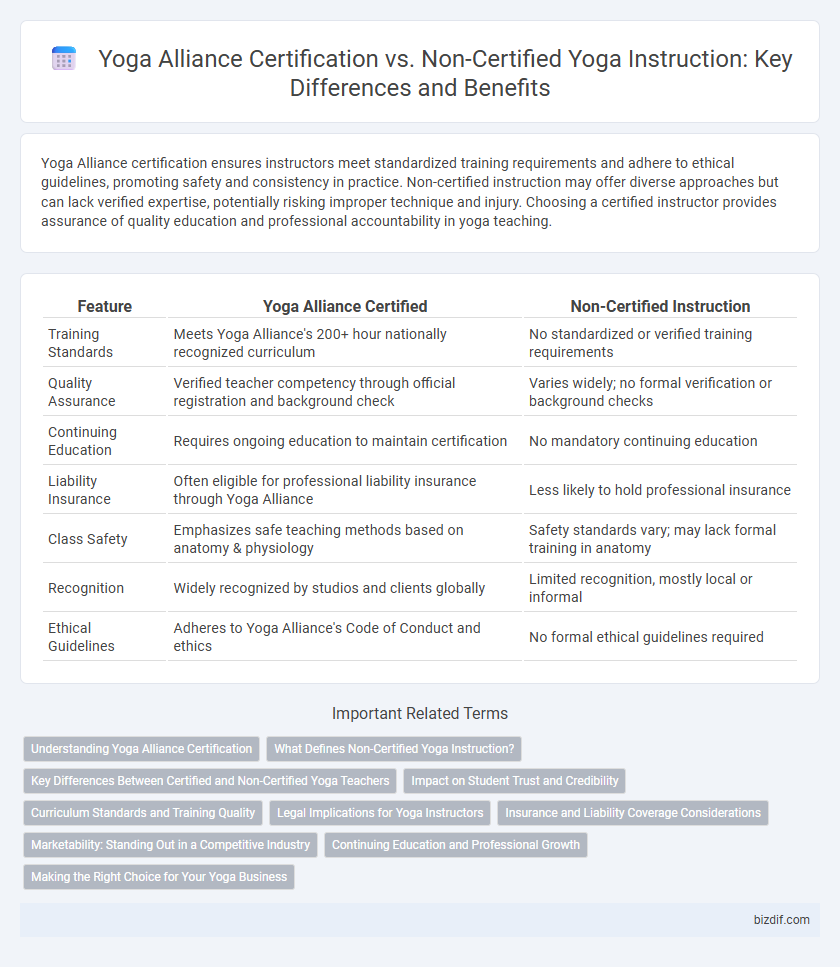Yoga Alliance certification ensures instructors meet standardized training requirements and adhere to ethical guidelines, promoting safety and consistency in practice. Non-certified instruction may offer diverse approaches but can lack verified expertise, potentially risking improper technique and injury. Choosing a certified instructor provides assurance of quality education and professional accountability in yoga teaching.
Table of Comparison
| Feature | Yoga Alliance Certified | Non-Certified Instruction |
|---|---|---|
| Training Standards | Meets Yoga Alliance's 200+ hour nationally recognized curriculum | No standardized or verified training requirements |
| Quality Assurance | Verified teacher competency through official registration and background check | Varies widely; no formal verification or background checks |
| Continuing Education | Requires ongoing education to maintain certification | No mandatory continuing education |
| Liability Insurance | Often eligible for professional liability insurance through Yoga Alliance | Less likely to hold professional insurance |
| Class Safety | Emphasizes safe teaching methods based on anatomy & physiology | Safety standards vary; may lack formal training in anatomy |
| Recognition | Widely recognized by studios and clients globally | Limited recognition, mostly local or informal |
| Ethical Guidelines | Adheres to Yoga Alliance's Code of Conduct and ethics | No formal ethical guidelines required |
Understanding Yoga Alliance Certification
Yoga Alliance Certification establishes a standardized benchmark ensuring instructors possess comprehensive training in anatomy, safety, and teaching methodology, which non-certified instructors may lack. This certification enhances credibility and offers access to a global network of professionals and continuing education resources. Recognizing the significance of Yoga Alliance standards helps students select qualified instructors committed to maintaining professional ethics and quality instruction.
What Defines Non-Certified Yoga Instruction?
Non-certified yoga instruction refers to teaching practices conducted by individuals who have not completed the standardized training or met the credentialing requirements set by Yoga Alliance. This type of instruction may lack adherence to established safety protocols, anatomical guidelines, and teaching methodologies integral to certified programs. Practitioners seeking non-certified instruction should carefully evaluate the instructor's experience and qualifications to ensure a safe and effective yoga practice.
Key Differences Between Certified and Non-Certified Yoga Teachers
Yoga Alliance certification ensures instructors meet standardized training hours, curriculum requirements, and professional ethics, providing a verified level of expertise. Non-certified teachers may lack formal training, resulting in variable teaching quality and potential gaps in anatomical knowledge or safety protocols. Certified instructors typically have access to continuing education and professional networks, enhancing their credibility and students' trust.
Impact on Student Trust and Credibility
Yoga Alliance Certification enhances student trust by validating instructor qualifications through standardized training hours and ethics codes, thereby boosting credibility and professional recognition. Non-certified instructors may face challenges in establishing authority and confidence among students due to the absence of verified credentials and consistent quality assurance. Ensuring certification aligns with student expectations for safety, expertise, and authenticity in yoga practice.
Curriculum Standards and Training Quality
Yoga Alliance Certification ensures adherence to rigorous curriculum standards, including a minimum of 200 hours in foundational techniques, anatomy, and teaching methodology, which significantly enhances training quality. Non-certified instruction often lacks standardized curriculum requirements, resulting in varying levels of training depth and potential gaps in teacher preparedness. Certified instructors possess validated skills and comprehensive knowledge, providing students with safer and more effective yoga experiences.
Legal Implications for Yoga Instructors
Yoga Alliance Certification provides a recognized standard that can protect instructors legally by demonstrating adherence to established training and ethical guidelines. Non-certified yoga instructors may face increased liability risks due to lack of formal credentials and difficulty proving competence in legal disputes. Carrying proper liability insurance is crucial regardless of certification status to mitigate legal consequences associated with teaching yoga.
Insurance and Liability Coverage Considerations
Yoga Alliance Certification provides instructors with verification that meets industry standards, often qualifying them for professional liability insurance required by most studios and gyms. Non-certified instructors may face challenges obtaining comprehensive insurance coverage, increasing personal liability risks and limiting opportunities to teach in insured venues. Prioritizing Yoga Alliance certification ensures better protection against claims and greater credibility in the insurance market.
Marketability: Standing Out in a Competitive Industry
Yoga Alliance Certification significantly enhances marketability by demonstrating adherence to standardized training and ethical teaching practices, which builds trust and credibility with students and employers. Non-certified instruction may lack recognized credentials, making it harder to attract clients and gain visibility in a competitive market. Certified instructors benefit from brand recognition, networking opportunities, and access to a larger client base seeking professionally accredited guidance.
Continuing Education and Professional Growth
Yoga Alliance Certification offers structured continuing education that ensures instructors stay updated with evolving practices and safety standards, fostering consistent professional growth. Non-certified instruction may lack standardized pathways for ongoing learning, potentially limiting skill development and knowledge expansion. Maintaining certification through Yoga Alliance encourages commitment to lifelong education and elevates teaching credibility.
Making the Right Choice for Your Yoga Business
Choosing Yoga Alliance certification for your yoga business enhances credibility by meeting established standards for training hours, curriculum, and teacher qualifications, which attracts clients seeking qualified instructors. Non-certified instruction may offer flexibility and lower upfront costs but often lacks industry recognition, making it harder to build trust and grow your client base. Prioritizing Yoga Alliance certification supports professional development, client confidence, and long-term business sustainability in the competitive yoga market.
Yoga Alliance Certification vs Non-Certified Instruction Infographic

 bizdif.com
bizdif.com